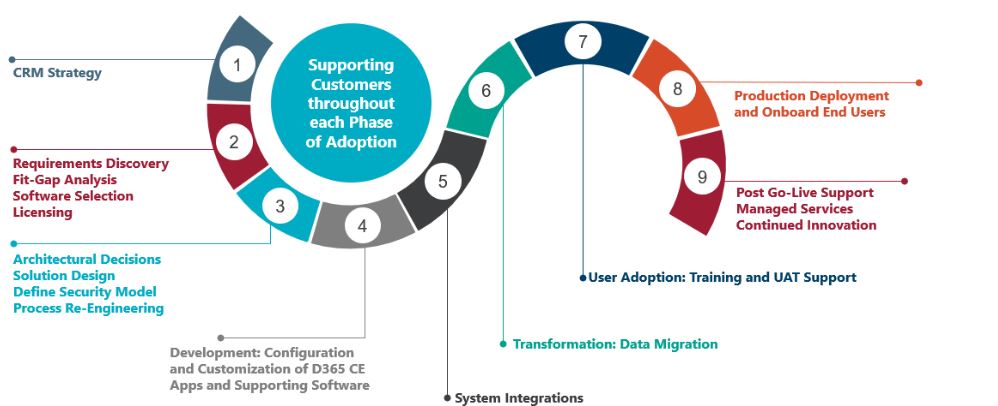In this rapidly evolving digital age, unifying customer data and providing a 360-degree view of the various interactions and relationships across lines of business will enable organizations with a more proactive approach to engage customers to accelerate business results. Customer engagement is a hot topic, and there is no shortage of blogs and articles that provide varying degrees of insights on this subject. In simple terms, customer engagement is about the activities by organizations to interact with their customers and the underlying relationships that are developed. These interactions can occur via different channels with the goal of providing rich and informed content to the target audience, offering a platform to easily and effectively exchange information, while streamlining the end-user experience. This, in turn, establishes and strengthens connections with the target audience, increasing customer loyalty and satisfaction for the servicing organizations.
With the Microsoft Dynamics 365 Customer Engagement (CE) platform (which provides purpose-built applications, such as sales, customer service, field service and marketing), organizations can transform their business to better connect with their customers, collect insightful data about those interactions, and automate business processes to make informed and intelligent decisions. Microsoft Dynamics 365 CE is more than a CRM solution. Its unified relational database allows organizations to leverage a robust data model to collect information and relationships. Dynamics 365 CE applications are easy to adopt with out-of-the-box industry-specific features that organizations can run their business on quickly out of the gate, but yet sophisticated enough to support complicated use cases. The applications are highly customizable and can be integrated with other systems for extended functionalities. They are also tightly integrated within the Microsoft ecosystem, meaning there is no data silo. The beauty of the platform’s modular design allows deployment to start with one application, and to onboard additional applications as the business scales up over time.
To achieve desired business outcomes, strategic planning and execution are vital to ensure a successful rollout of any Dynamics 365 CE implementation. How to best support end-users throughout the delivery cycle below should be considered to increase end-user adoption and allow organizations to maximize their investment.

Leveraging the fundamentals of Microsoft Dynamics Sure Step, which is a prescribed methodology for deploying Dynamics 365 CE solutions, the overall delivery cycle depicted above can be broken down into the following phases and objectives:
Discovery Phase
- Cloud strategy, roadmap and skills readiness
- Requirements analysis workshops
- Review and selection of Dynamics 365 CE apps
- Licensing, governance and advisory services
Design Phase
- Solution architecture
- Security model
- Data structure and entity relationships
- Integration and data migration approach
Implementation Phase
- Configuration of Dynamics 365 CE apps
- Custom development of solution components
- Integration with LOB systems and extension with Power Platform
- Data migration from third-party sources
Optimization Phase
- Streamlined architectural design
- Business Process Automation
- Extended solution capabilities
- Customer insights
Transition Phase
- Training and knowledge transfer
- Change management support
- Solution deployment and post go-live support
- Managed services and enhancements
Execution of the above phases and objectives is centered around the following success factors:
- Plan strategically to ensure organizational and infrastructure readiness for adopting the Dynamics 365 CE platform in the cloud. Selection of appropriate Dynamics 365 CE apps to align with business goals.
- Select champions for the Dynamics 365 CE roadmap and obtain executive stakeholders’ commitment. Involve stakeholders early in the process to ensure an understanding of positive outcomes.
- Clear definition of implementation process scope and timeline, including integration and data migration requirements with other LOB systems. It’s important to appoint a product owner to prioritize those requirements and to consider a multi-phase approach to avoid competing functionalities.
- Consider a holistic view of the Dynamics 365 CE implementation process with the broader Microsoft ecosystem, extending applications with high business value features to gain insights, operational efficiency and a better end-user experience.
- Execution of organizational change management to address end-user resistance and feedback and invest additional resources for continued innovation and adoption.
Deployment of Dynamics 365 CE solutions can be found in industries ranging from financial services, education, healthcare, telecommunications, and retail, to government and non-profits. Protiviti was instrumental in leading the implementation of a large-scale multi-year digital transformation project for a national non-profit organization in Canada to migrate the client’s legacy on-premises CRM system to the Dynamics 365 CE online platform. Leveraging the sales and customer service applications at the core, the solution has enabled the client to more effectively engage and collect data from their member communities. Staff from the client’s internal operations are able to gain efficiency by utilizing the advanced search and reporting capabilities of the platform.
Organizations looking to embark on the journey of digital transformation with Dynamics 365 CE should start with a thorough discovery phase to survey the existing business and technological landscape. From tactical strategy considerations, and industry-leading development practices, to organizational change management, it’s a collaborative approach between all stakeholders involved to successfully plot, navigate and complete the journey of deploying Dynamics 365 CE solutions.
To learn more about our Microsoft consulting solutions, contact us.



